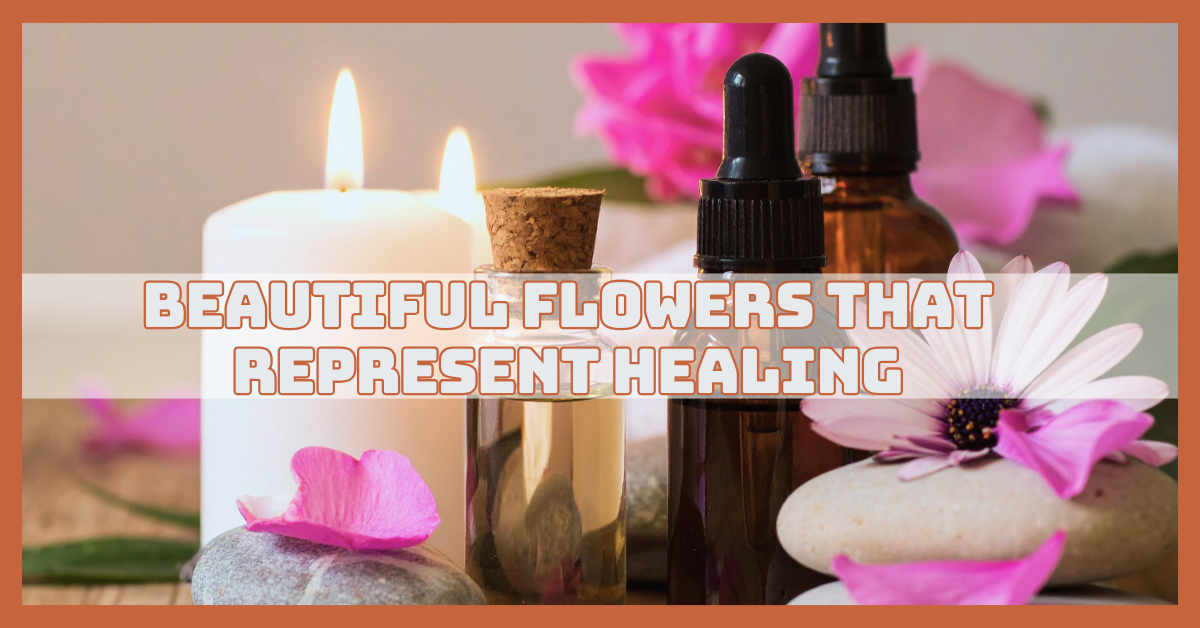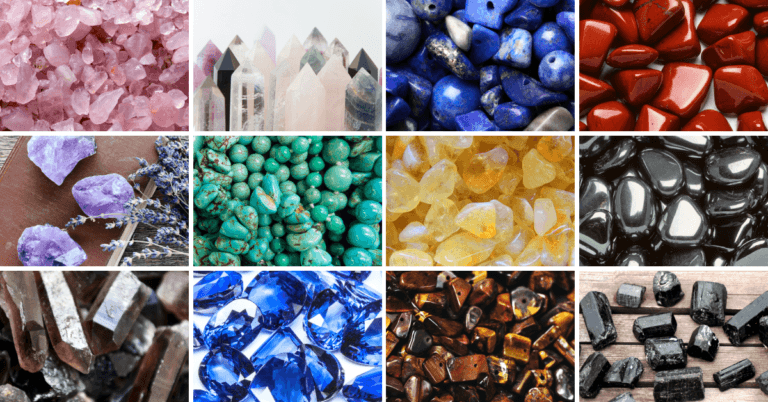Beautiful Flowers That Represent Healing
“Where flowers bloom, so does hope.” — Lady Bird Johnson
Flowers have always been more than just beautiful decor. For centuries, people have turned to them for healing — emotionally, spiritually, and even physically. Each flower carries energy, meaning, and symbolism that can help us reconnect with peace, comfort, and renewal.
In this guide, we’ll explore flowers that represent healing — their meanings, uses, and the way they nurture the heart and soul.
Whether you’re building a healing garden, gifting someone, or looking for floral therapy, these blooms will lift your spirit.
Beautiful Flowers That Represent Healing And Positivity
1. Lavender – The Soothing Flower of Calm
Lavender works as a natural relaxant, helping the mind unwind and the body release tension. Its scent lowers cortisol levels, which reduces anxiety and promotes deep sleep.
You can use lavender in essential oil diffusers, calming bath soaks, or homemade sleep sachets. Fresh blooms can be added to warm baths to melt away stress.
To preserve lavender, hang the stems upside down in a dark, dry space for about two weeks, then store them in airtight glass jars.
Keep them out of sunlight to maintain colour and aroma. Lavender teaches that true healing often begins with calmness and stillness.
2. Chamomile – The Gentle Healer of Rest
Chamomile works as a natural sedative and anti-inflammatory. Its daisy-like petals contain apigenin, a compound that promotes relaxation and better sleep.
Drinking chamomile tea daily helps soothe nerves, stomach issues, and mild headaches. You can also create a calming face steam using dried chamomile flowers for skin and mood therapy.
To preserve chamomile, dry the blooms on a mesh tray in a cool area, then store them in glass jars away from moisture.
You can keep them for up to a year if sealed well. Chamomile’s gentle energy reminds us that healing doesn’t have to be rushed — it flows naturally.
3. Rose – The Flower of Emotional Healing
Roses heal the heart. Their fragrance activates feelings of love, compassion, and comfort. Rose oil is known to calm anxiety, ease grief, and restore emotional balance.
You can infuse rose petals into warm baths, make rosewater for skincare, or use rose tea for gentle detoxification. To store, dry petals naturally by spreading them on parchment in the shade, and once dry, keep them in glass jars or cloth pouches.
To absorb the moisture, add a few grains of rice. Roses remind us that healing often begins with self-love — learning to nurture yourself the way you’d care for something fragile and beautiful.
4. Sunflower – The Bright Energy Restorer
Sunflowers symbolize joy, strength, and optimism. They work by uplifting mood and increasing energy through their bright, sunny presence.
The seeds are full of vitamins and healthy fats that support heart and brain health. You can eat sunflower seeds as snacks, use the oil for massage or cooking, and decorate your space with fresh or dried blooms to invite positivity.
To preserve, hang the flower heads upside down until dry, then keep the petals in paper envelopes. Store seeds in airtight containers.
Sunflowers remind us to follow the light — their natural behaviour of turning toward the sun mirrors emotional resilience.
5. Jasmine – The Flower of Emotional Renewal
Jasmine works as an emotional cleanser. Its intoxicating fragrance relaxes the nervous system, balances hormones, and enhances feelings of confidence and peace.
You can use jasmine essential oil in diffusers, add the flowers to green tea, or mix them into homemade potpourri. Dried jasmine can also be placed in linen sachets for a relaxing scent that helps with sleep.
To store, dry jasmine flowers in shade and keep them sealed in airtight tins or jars. Its scent stays fresh for months. Jasmine teaches that healing happens quietly — through moments of softness, breath, and self-appreciation.
6. Tulip – The Flower of Forgiveness and Renewal
Tulips carry gentle healing energy that encourages letting go and starting fresh. The flower’s simplicity symbolizes self-forgiveness and emotional clarity.
You can use tulip petals in facial steams for their mild cleansing properties or dry them for spiritual journaling and art. When gifted, tulips express reconciliation and emotional care.
To preserve, spread the petals on paper and let them air-dry for several days. Once dried, store them between tissue layers in a box. Tulips remind us that healing requires patience — it unfolds one layer at a time, just like petals opening in spring.
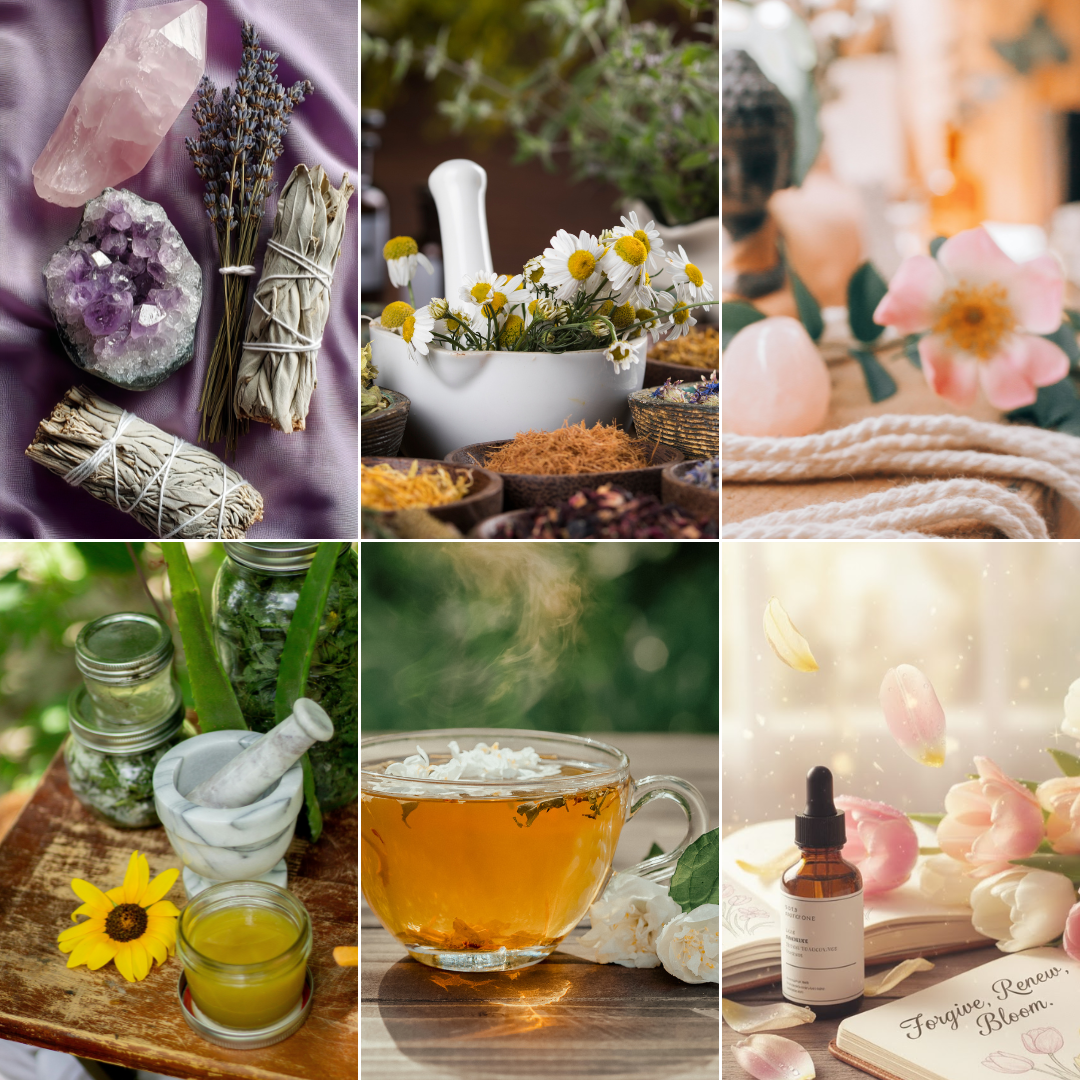
7. Peony – The Flower of Compassion and Comfort
Peonies represent emotional healing, protection, and renewal. Their lush blooms soothe heavy hearts and bring calming energy into any space.
The roots are used in herbal medicine to relieve pain and regulate emotions, while the fragrance comforts anxiety. You can use dried petals in potpourri, or soak them in warm baths to refresh your energy.
To store dry peonies in a cool room and keep the petals sealed in jars or sachets. The fragrance lasts long if stored away from humidity.
Peonies remind us that strength often looks soft — healing doesn’t mean hardening, it means blooming again after loss.
8. Calendula – The Golden Healer
Calendula, also known as marigold, works wonders for physical and emotional healing. Its petals are perfect for wound healing and skin care because they have antibacterial and anti-inflammatory qualities.
You can make calendula oil by infusing petals in olive oil or add them to tea for inner cleansing. To store, dry petals on paper towels and keep them in dark glass jars. The bright orange colour stays vibrant for months.
Calendula’s warmth heals the spirit, too — it teaches self-care and positivity. Just like sunshine after rain, this flower restores balance and encourages joyful living.
9. Echinacea – The Flower of Resilience
Echinacea strengthens immunity and symbolizes endurance. Its petals and roots are used in herbal teas to prevent colds and fatigue. Drinking echinacea tea supports recovery and builds resistance against infections.
You can also dry the flower heads to make homemade immune boosters. To store, dehydrate petals and roots completely before sealing them in jars. Keep them in a dark, cool cabinet to retain potency.
Echinacea works by reminding us that healing often requires both inner strength and consistency. It’s the perfect flower for anyone rebuilding energy — a natural emblem of perseverance and vitality.
10. Lotus – The Flower of Spiritual Healing
The lotus is sacred across cultures for its message of rebirth. It grows from muddy water, yet emerges pure and serene — symbolizing emotional cleansing and spiritual awakening.
Lotus petals can be steeped in tea to calm the mind or used in meditation spaces for peace. Lotus essential oil helps with grounding and emotional release. To preserve, dry petals gently and store them pressed between clean papers.
Lotus works by teaching acceptance — it shows that pain can be the soil for growth. Keeping lotus imagery or flowers nearby brings serenity and self-awareness to your daily life.
11. Daffodil – The Flower of Hope and Renewal
Daffodils bloom at the end of winter, bringing a sense of renewal and hope. They work as emotional energizers, symbolizing recovery after hardship.
You can use dried daffodils in herbal blends, or simply display them fresh in bright rooms to lift your spirit. Their scent is light and optimistic, perfect for improving mood.
To store, dry daffodil blooms on mesh racks and keep them in breathable pouches. Daffodils remind us that no matter how long the darkness lasts, new life eventually emerges. They carry the energy of rebirth and gentle transformation.
12. Magnolia – The Flower of Inner Strength
Magnolia symbolizes grace, perseverance, and emotional stability. Its creamy white blossoms have a sweet fragrance that relaxes the senses and encourages clarity.
Magnolia essential oil is often used in aromatherapy to reduce anxiety and insomnia. You can add dried petals to bathwater for relaxation or use magnolia tea for emotional detox.
To store, spread petals in a single layer to dry naturally, then keep them in sealed jars away from sunlight. Magnolia works by reminding us that true healing isn’t about being unshaken — it’s about staying graceful through life’s winds.
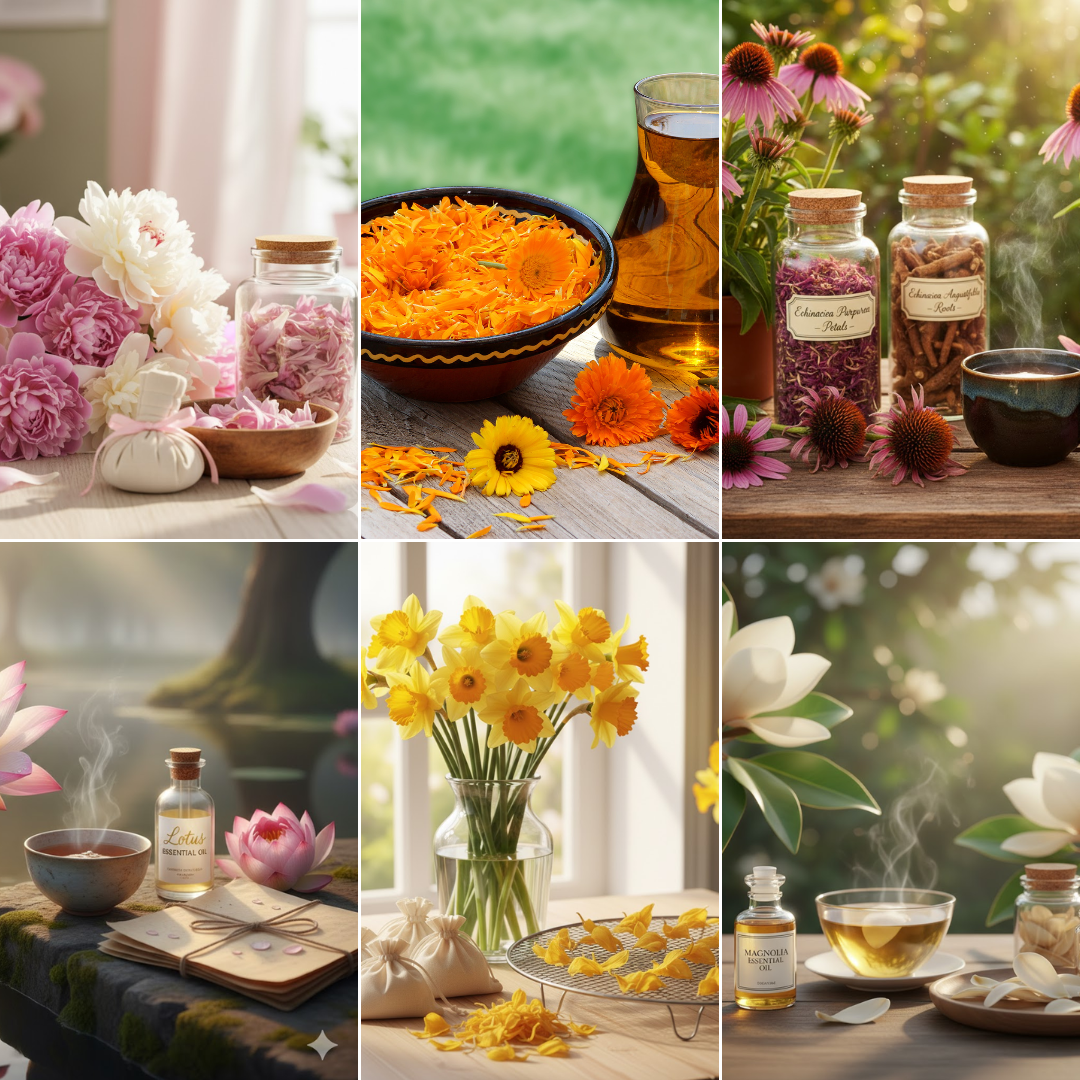
13. Geranium – The Flower of Balance
Geranium restores emotional equilibrium and physical energy. Its scent balances hormones, eases tension, and uplifts mood. You can diffuse geranium essential oil during meditation, or brew a mild tea for internal cleansing.
Add dried leaves to potpourri or floral sachets for a long-lasting, refreshing fragrance. To preserve, dry flowers flat and store them in glass jars. Keep them in cool, dark places.
Geranium works by aligning mind and heart energy — helping you remain calm and focused. Its soft pink or red blooms remind you to center yourself and maintain harmony, no matter how chaotic life gets.
14. Lotus Lily – The Flower of Emotional Cleansing
Lotus lilies are associated with flow and emotional release. Their delicate presence in water symbolizes serenity and purification.
You can float fresh blooms in a bowl during meditation to calm the energy of your home or dry petals for healing teas. To preserve them, dehydrate slowly and store them in breathable paper bags.
Lotus lilies work by promoting gentle emotional flow, helping you process feelings rather than suppressing them. They bring peace to restless minds and balance to the spirit. These flowers remind us that healing comes from allowing emotions to move freely like water.
15. Hibiscus – The Flower of Vital Energy
Hibiscus enhances vitality and beauty from within. Its petals are full of antioxidants that promote heart health and rejuvenate the skin. Hibiscus tea helps lower blood pressure and supports energy renewal.
You can also use the flowers in hair masks for shine and strength. To store, dry the petals completely and keep them sealed in glass jars.
Hibiscus works energetically by awakening passion and self-confidence. Its bold red colour symbolizes courage — a reminder to live vibrantly. Whether used as tea or decoration, hibiscus helps you reconnect with your life force.
Turn Your Passion for Nature Into Income
🌿 Whether you love gardening, caring for animals, or exploring holistic living,
You can share your knowledge online and earn from it.
Discover how nature lovers are growing their passions into meaningful, income-generating blogs. 👇
16. Bluebell – The Flower of Gratitude
Bluebells carry the energy of thankfulness and emotional peace. Their soft blue blooms encourage mindfulness and humility. You can use pressed bluebells in gratitude journals or dried arrangements to enhance tranquillity at home.
For preservation, dry them slowly between paper sheets and store them in a cool drawer. Bluebells work by reminding us to appreciate life’s small blessings — a vital step in healing.
Their energy brings comfort, helping you release regret and embrace presence. They whisper that gratitude itself is medicine — a quiet yet powerful healer of the heart.
17. Yarrow – The Flower of Courage and Protection
Yarrow has long been used to heal physical wounds, but it also protects emotional energy. It strengthens boundaries and helps overcome fear.
Yarrow tea boosts immunity and eases tension, while its essential oil supports skin repair. You can keep dried yarrow bunches at home for energetic protection. To store, hang upside down until crisp, then seal in jars.
Yarrow works by reinforcing both body and spirit — giving courage to heal deeply without reopening old wounds. It’s the flower that teaches strength with tenderness, reminding you that resilience can coexist with softness.
18. Aloe Vera – The Flower of Recovery
Aloe vera’s healing properties are legendary. Its gel soothes burns, hydrates skin, and detoxifies the body. The small yellow aloe flowers symbolize endurance and vitality.
You can apply aloe gel directly or store it in the fridge for long-term use. Dried aloe flowers can be kept in paper bags. Aloe works by regenerating — it literally helps new skin grow.
Spiritually, it teaches adaptability and strength under harsh conditions. Keeping an aloe plant indoors purifies the air and invites constant healing energy. It’s nature’s profound yet straightforward healer.
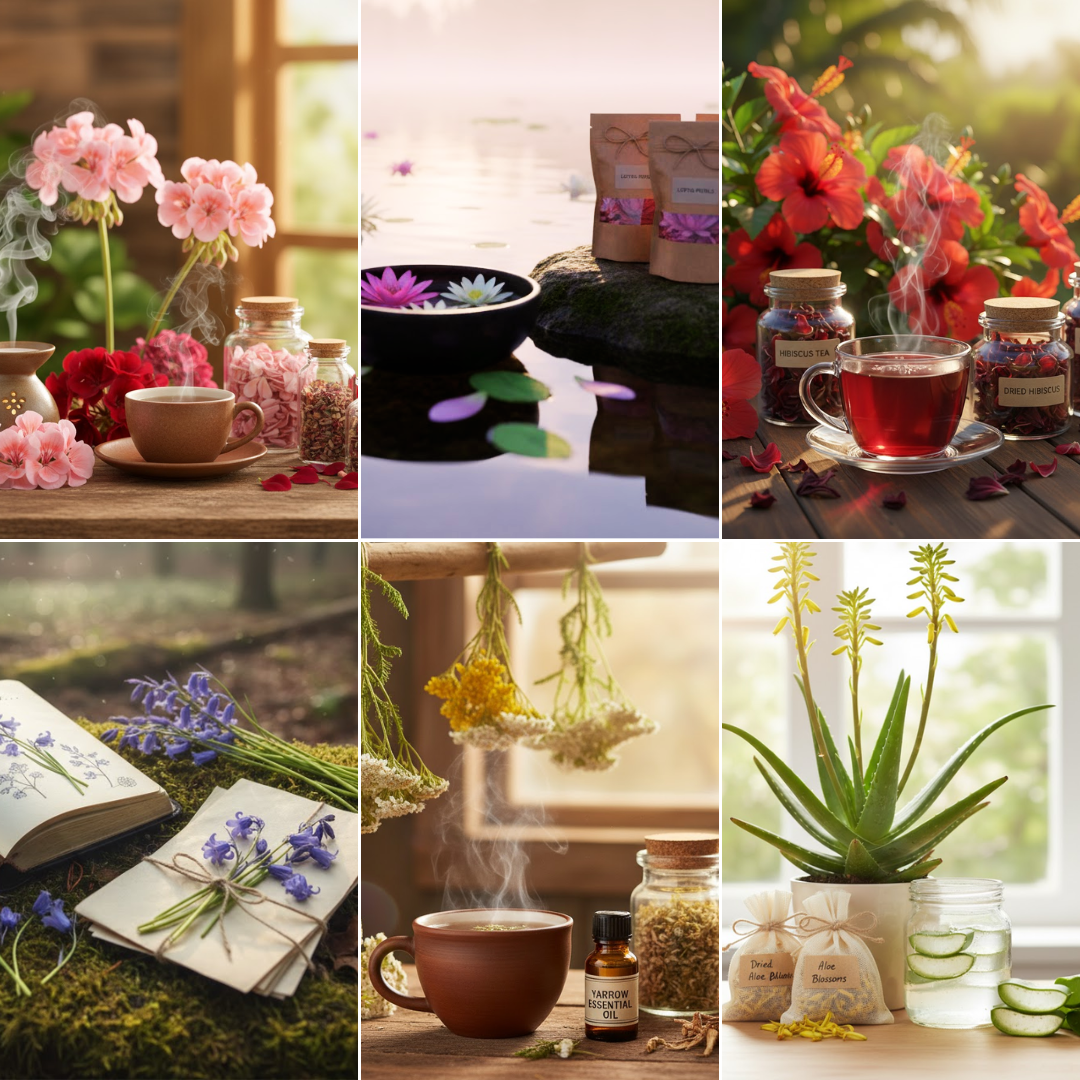
19. Forget-Me-Not – The Flower of Memory and Connection
Forget-me-nots represent eternal love and gentle remembrance. They work emotionally by soothing grief and strengthening bonds.
You can press them in books, add them to resin art, or keep small dried bundles in glass jars as memorial tokens. Their soft blue colour brings peace to emotional hearts.
To store, dry naturally and seal in containers with silica gel packets to prevent moisture. Forget-me-nots work by honouring memories — helping you cherish connections instead of holding onto pain. Their presence is a reminder that love, once shared, never truly leaves.
20. Sage Blossom – The Flower of Cleansing and Wisdom
Sage blossoms purify energy, promote clarity, and calm the mind. Burning dried sage, or “smudging,” clears negative vibrations from your space. Additionally, sage essential oil can be used for therapeutic baths or meditation.
To store, dry the blossoms and keep them in tightly sealed jars. Crush small amounts when needed to release their aroma.
Sage works by cleansing — both physically and spiritually — allowing new energy to enter. It reminds you that healing often requires release and renewal. Sage brings wisdom, peace, and fresh air to tired souls.
21. Honeysuckle – The Flower of Emotional Healing
Honeysuckle symbolizes emotional healing and renewal. Its sweet fragrance is known to lift mood and reduce anxiety. You can use honeysuckle in herbal teas to help with digestion and stress relief.
Additionally, the flowers can be put in bath water to promote relaxation or incorporated into oil to relieve skin irritations.
To store honeysuckle, dry the blossoms in a shaded, airy place, then keep them in airtight glass jars away from moisture.
Their essence works by calming the nervous system and promoting emotional balance—making honeysuckle a gentle yet powerful remedy for both mind and body.
22. Sage Flower – The Purifier and Protector
Sage flowers represent purification and spiritual healing. They clear negativity and bring mental clarity. You can use them by steeping the flowers in tea for respiratory support or making smudge bundles for cleansing spaces.
Sage oil also helps relieve sore muscles and calm nerves. Store dried sage flowers in a cool, dark place wrapped in parchment or sealed jars to preserve their aroma and potency.
Sage works through its antimicrobial and mood-balancing properties, promoting overall harmony and renewal. It’s an ancient favorite for those seeking both physical detox and spiritual grounding.
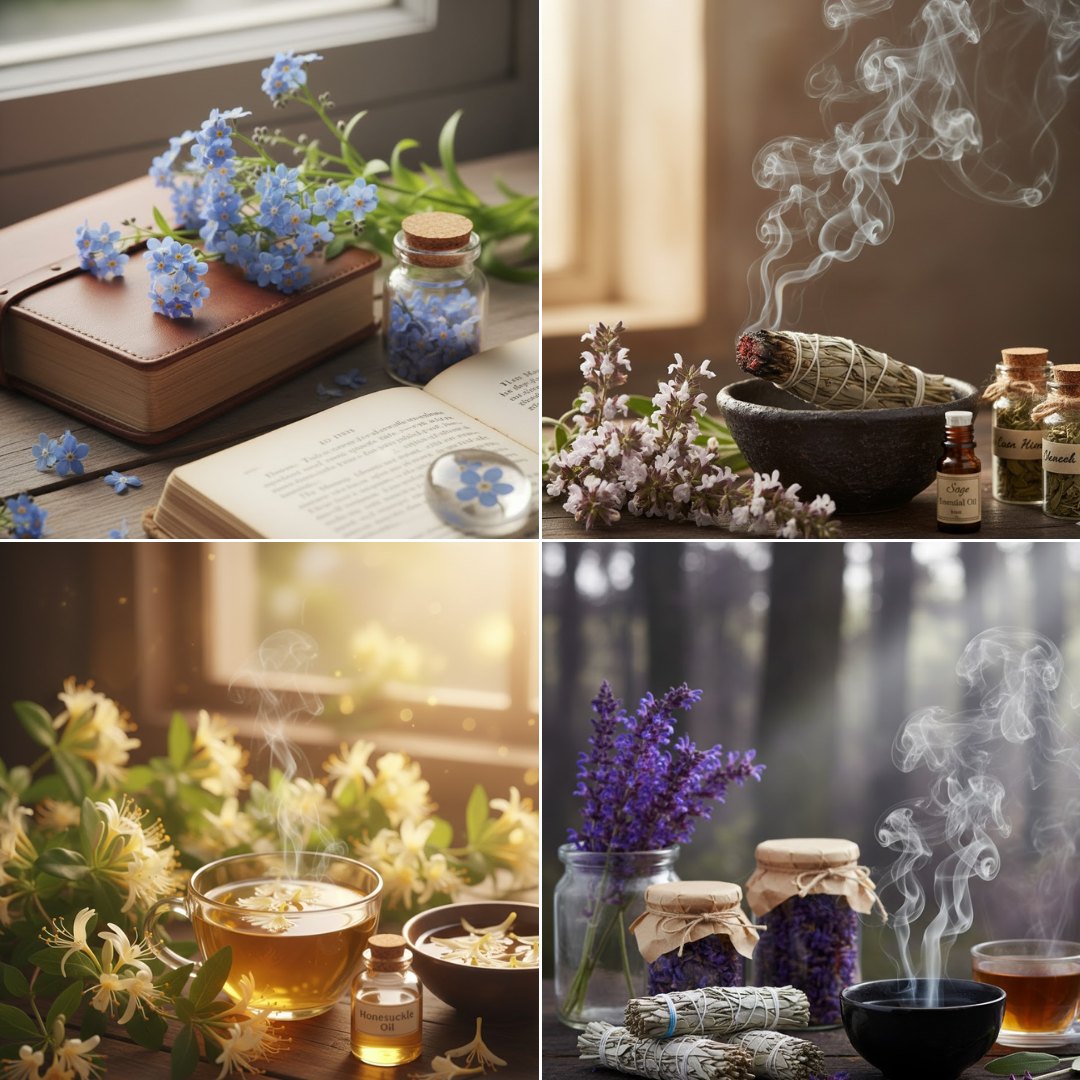
FAQs
What’s The Best Way To Preserve Healing Flowers?
Dry your flowers in a well-ventilated, shaded area. Once completely dry, store them in airtight glass containers away from direct sunlight and humidity.
This preserves their colour, fragrance, and healing properties for months, allowing you to use them in teas, oils, or crafts.
Are Healing Flowers Safe For Everyone To Use?
Most healing flowers are safe, but if you’re pregnant, nursing, or allergic to pollen, consult an herbalist before internal use. Always use a tiny patch of skin to test essential oils. Natural doesn’t always mean harmless—so mindful, moderate use is key for safety and balance.
Conclusion
Surrounding yourself with flowers that represent healing brings peace, positivity, and gentle transformation. Whether you sip them as tea, dry them for decor, or simply admire their colours, each flower offers a unique touch of comfort.
Let these natural healers inspire you to live more mindfully and stay connected with nature’s rhythm—because healing often begins with the beauty that grows around you.
I trust you enjoyed this article on the Beautiful Flowers That Represent Healing and Positivity. Please stay tuned for more inspiring guides, helpful tips, and ideas to help you live closer to nature every day.
Take care!
— JeannetteZ
💬 Your Opinion Is Important To Me
Do you have thoughts, ideas, or questions? I’d love to hear from you. Please leave your comments below or email me directly at Jeannette@Close-To-Nature.org.
📚 More Nature-Inspired Reads
Explore more ways to connect with nature, nurture your pets, and live in harmony with the world around you 🌿

